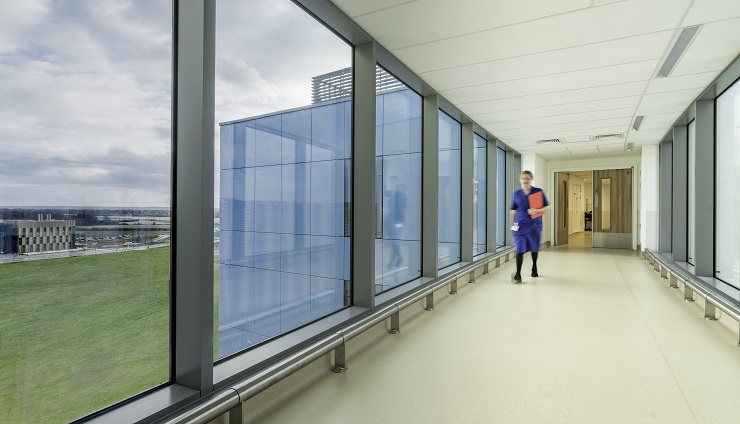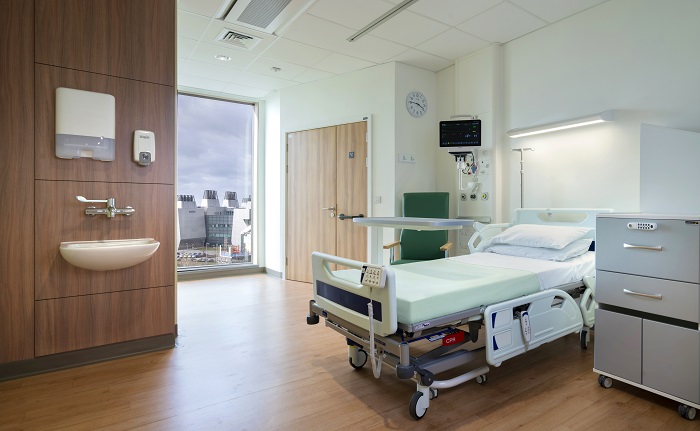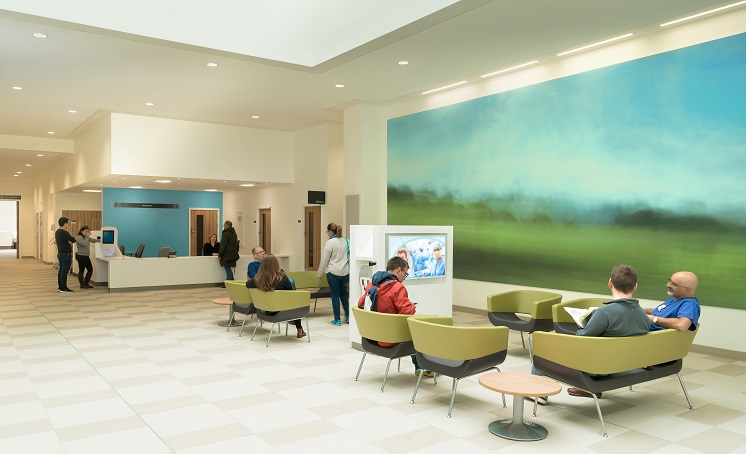Royal Papworth’s new hospital, a state-of-the-art heart and lung facility with more than 300 beds, has officially opened to the public.
HOK’s London Studio has led the architectural design for the cardiothoracic hospital’s new home on the Cambridge Biomedical Campus.
This is a world-class facility designed to set a new standard in patient care and support the wellbeing of visitors and staff
The holistic design concept embraces Royal Papworth Hospital NHS Foundation Trust’s ambition to thrive as one of the largest specialist cardiothoracic centres in Europe.
Built by Skanska, the striking architectural form, surrounded by its scenic landscaped parklands, welcomes visitors, patients and staff to the new building.
Simple wayfinding
Internally, it has been designed to be comforting and easy to navigate, helping to reduce stress and anxiety.
This is achieved through architectural features that distinguish the entrances, and through simple and clear spatial organisation which helps to make the wayfinding more intuitive.
The hospital is designed around two main atria located at the centre of the building where natural light and artwork help to create a calming, welcoming environment.
The main reception desk is visible from the entrance doors and located centrally for visitors or patients requiring support or direction.
And the lifts provide access to the inpatient floors and are located opposite the reception desk, as is the link into the outpatient atrium.
This area brings together testing, imaging and day wards, with each departmental entrance clearly visible for staff, patients and visitors.
This unique project will make a huge, long-term positive contribution to the local community and, more widely, to the healthcare profession
HOK’s design embraces the use of natural light together with the close co-location of the circulation elements, helping to make wayfinding for patients and their families as easy as possible.
In addition, the design of the new hospital promotes the trust’s model of care by creating separate zones for ambulatory or outpatient care, emergency services, diagnostic and treatment functions.
The clear separation of these areas creates an environment that is simple to navigate, streamlines admissions, and allows for efficient patient transfers.

Simple wayfinding and a calming, welcoming interior help to reduce stress and anxiety among patients and visitors
World-class outcomes
Colin Glen, project manager at Royal Papworth Hospital NHS Foundation Trust, said: "We are immensely proud of our new hospital, which is the culmination of many years of hard work from so many people.
“Every element of the build has been designed by clinicians with patients in mind to ensure a caring, safe, and relaxing environment for the more than 100,000 people we treat each year, as well as providing the best facilities for our staff to continue to deliver world-class outcomes."
Royal Papworth’s new location offers patients immediate access to a range of services and helps to attract leading clinicians and researchers.
A tranquil parkland setting, also designed by HOK, surrounds the building and features open, green spaces organised around a new duck pond, providing a connection to nature and helping with the healing process.
And HOK has developed an innovative strategy for the longevity of the building, designing it for the future and with the capacity to expand by 11,000sq m.
The ability to repurpose areas to suit evolving clinical needs is met by the building’s structure and engineering services strategy, together with the strategic placement of soft space.
By designing rooms with standardised size, shape and layout, these can be more easily reconfigured.
Kirstin Ziemer, a senior medical planner at HOK, explains: “As senior medical planner, this project has provided an exciting and rare opportunity to completely reinvent and modernise how Royal Papworth delivers patient care.
“Healthcare design is incredibly complex, especially for cardiothoracic treatment, but I loved the challenge this brief presented.
“The patient journey was a key focus for the design and this, in turn, influenced the clinical design, by creating a place where the talented clinicians at Royal Papworth would be proud to work.”

The hospital has more than 300 beds
Flexible for the future
“We were fortunate to engage with the clinicians very early on in the design process.” added Ziemer.
“Through these collaborative relationships, we developed a user group, which helped to define the brief.”
And Allison Wagner, regional leader of HOK’s healthcare practice, said: “This is a world-class facility designed to set a new standard in patient care and support the wellbeing of visitors and staff.
“The state-of-the-art building also recognises the rapid progress in clinical care, offering the flexibility for future expansion and reconfiguration.”
Throughout the hospital, HOK designed a variety of functional spaces for families, including in patient bedrooms.
Areas have also been designed for collaboration between family members and the care team when it comes to treatment planning.
And the design introduces internet spaces in the atria for patient and family access.
Every element of the build has been designed by clinicians with patients in mind to ensure a caring, safe, and relaxing environment for the more than 100,000 people we treat each year
The aim is that the holistic design will raise the level of access to clinical information while support a culture of transparency.
“It was clear that after listening and interpreting the client’s brief, Royal Papworth had to be the central focus on the vast Cambridge Biomedical Campus,” explained Ian Fleetwood, HOK’s lead designer on the project.
“The elegant, oval shape of the building complements this design philosophy.”
He added: “As a young boy I became very aware of the progression of modern science when Royal Papworth became world renowned for delivering the first successful heart transplant in the UK.
“It was therefore a great honour and privilege to design Royal Papworth’s new facility.
“This now takes centre stage at the innovative campus in Cambridge, allowing the hospital to continue its mission of medical advancement for cardiothoracic care and research.”

Inpatient and outpatient areas are clearly separated
State of the art
Artwork has been specially commissioned to bring public spaces to life. An integral part of the visioning process, HOK’s design team worked with the trust to identify key artists.
And the striking facade of the building was developed following detailed conversations with Royal Papworth consultant surgeon, Stephen Tsui.
He shared the story of a recent visit to Chicago where he came across the sculpture ‘Cloud Gate’ by Anish Kapoor.
He was drawn to the dynamism created by the sculpture’s mirrored surface, which engages the city skyline and reflects the constantly-changing environment.
He wondered whether it was possible for the new Royal Papworth to reflect the fact that healthcare is never static, that it too is constantly changing and evolving.
HOK’s team worked on the finish of the glass, carefully testing and selecting the curtain walling system to develop this concept of a dynamic reflection, and to create a building that reflects and represents its ever-changing environment.
“This unique project will make a huge, long-term positive contribution to the local community and, more widely, to the healthcare profession,” said Charlie Norris, project director at Skanska.
